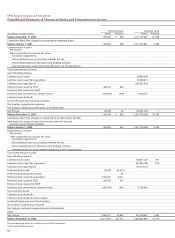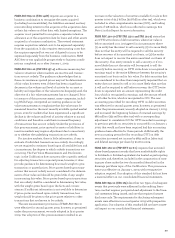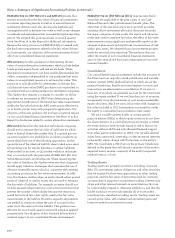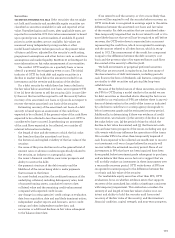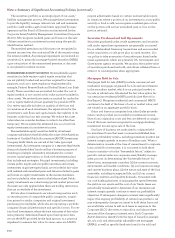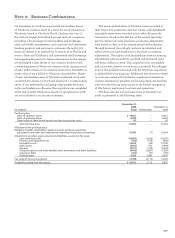Wells Fargo 2009 Annual Report Download - page 103
Download and view the complete annual report
Please find page 103 of the 2009 Wells Fargo annual report below. You can navigate through the pages in the report by either clicking on the pages listed below, or by using the keyword search tool below to find specific information within the annual report.
Securities
SECURITIES AVAILABLE FOR SALE Debt securities that we might
not hold until maturity and marketable equity securities are
classified as securities available for sale and reported at fair
value. Unrealized gains and losses, after applicable taxes, are
reported in cumulative OCI. Fair value measurement is based
upon quoted prices in active markets, if available. If quoted
prices in active markets are not available, fair values are
measured using independent pricing models or other
model-based valuation techniques such as the present value
of future cash flows, adjusted for the security’s credit rating,
prepayment assumptions and other factors such as credit loss
assumptions and market liquidity. See Note 16 in this Report for
more information on fair value measurement of our securities.
We conduct OTTI analysis on a quarterly basis or more
often if a potential loss-triggering event occurs. The initial
indicator of OTTI for both debt and equity securities is a
decline in market value below the amount recorded for an
investment and the severity and duration of the decline.
For a debt security for which there has been a decline in
the fair value below amortized cost basis, we recognize OTTI
if we (1) have the intent to sell the security, (2) it is more like-
ly than not that we will be required to sell the security before
recovery of its amortized cost basis, or (3) we do not expect to
recover the entire amortized cost basis of the security.
Estimating recovery of the amortized cost basis of a debt
security is based upon an assessment of the cash flows
expected to be collected. If the present value of the cash flows
expected to be collected is less than amortized cost, OTTI is
considered to have occurred. In performing an assessment
of the cash flows expected to be collected, we consider all
relevant information including:
• the length of time and the extent to which the fair value
has been less than the amortized cost basis;
• the historical and implied volatility of the fair value of the
security;
• the cause of the price decline such as the general level of
interest rates or adverse conditions specifically related to
the security, an industry or a geographic area;
• the issuer’s financial condition, near-term prospects and
ability to service the debt;
• the payment structure of the debt security and the
likelihood of the issuer being able to make payments
that increase in the future;
• for asset-backed securities, the credit performance of the
underlying collateral, including delinquency rates, level
of non-performing assets, cumulative losses to date,
collateral value and the remaining credit enhancement
compared with expected credit losses;
• any change in rating agencies’ credit ratings at evaluation
date from acquisition date and any likely imminent action;
• independent analyst reports and forecasts, sector credit
ratings and other independent market data; and
• recoveries or additional declines in fair value subsequent
to the balance sheet date.
If we intend to sell the security, or if it is more likely than
not we will be required to sell the security before recovery, an
OTTI write-down is recognized in earnings equal to the entire
difference between the amortized cost basis and fair value
of the security. For debt securities that are considered other-
than-temporarily impaired that we do not intend to sell or it is
more likely than not that we will not be required to sell before
recovery, the OTTI write-down is separated into an amount
representing the credit loss, which is recognized in earnings,
and the amount related to all other factors, which is recog-
nized in OCI. The measurement of the credit loss component
is equal to the difference between the debt security’s cost
basis and the present value of its expected future cash flows
discounted at the security’s effective yield.
We hold investments in perpetual preferred securities
(PPS) that are structured in equity form, but have many of
the characteristics of debt instruments, including periodic
cash flows in the form of dividends, call features, ratings that
are similar to debt securities and pricing like long-term
callable bonds.
Because of the hybrid nature of these securities, we evalu-
ate PPS for OTTI using a model similar to the model we use
for debt securities as described above. Among the factors we
consider in our evaluation of PPS are whether there is any evi-
dence of deterioration in the credit of the issuer as indicated
by a decline in cash flows or a rating agency downgrade to
below investment grade and the estimated recovery period.
Additionally, in determining if there was evidence of credit
deterioration, we evaluate: (1) the severity of decline in mar-
ket value below cost, (2) the period of time for which the
decline in fair value has existed, and (3) the financial condi-
tion and near-term prospects of the issuer, including any spe-
cific events which may influence the operations of the issuer.
We consider PPS to be other-than-temporarily impaired if
cash flows expected to be collected are insufficient to recover
our investment or if we no longer believe the security will
recover within the estimated recovery period. None of our
investments in PPS that have not been impaired have been
downgraded below investment grade subsequent to purchase,
and we believe that there are no factors to suggest that we
will not fully realize our investment in these instruments over
a reasonable recovery period. OTTI write-downs of PPS are
recognized in earnings equal to the difference between the
cost basis and fair value of the security.
For marketable equity securities other than PPS, OTTI
evaluations focus on whether evidence exists that supports
recovery of the unrealized loss within a timeframe consistent
with temporary impairment. This evaluation considers the
severity of and length of time fair value is below cost, our
intent and ability to hold the security until forecasted
recovery of the fair value of the security, and the investee’s
financial condition, capital strength, and near-term prospects.



